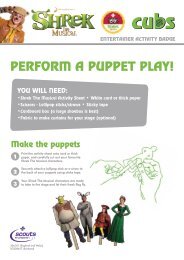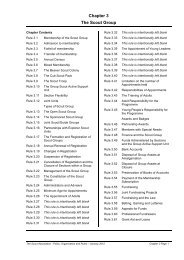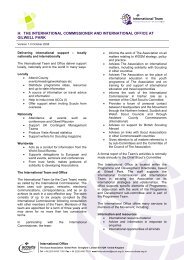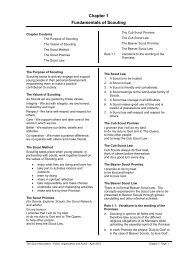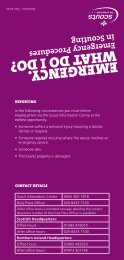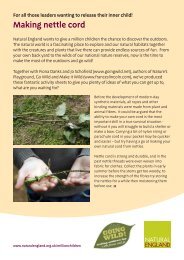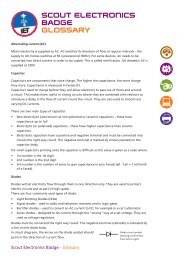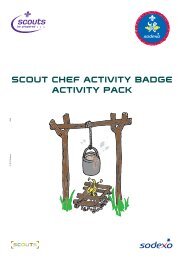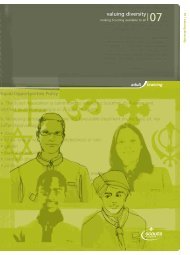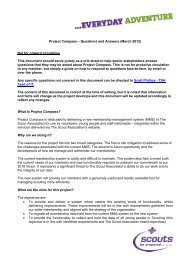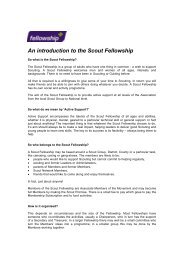Fun facts learning cards
Fun facts learning cards
Fun facts learning cards
You also want an ePaper? Increase the reach of your titles
YUMPU automatically turns print PDFs into web optimized ePapers that Google loves.
Sodexo Food Facts and <strong>Fun</strong><br />
Bite into food fact fun for Cubs!<br />
FOOD<br />
<strong>facts</strong> and fun<br />
These <strong>cards</strong> have been created to help you understand food better.<br />
We all know how important food is, so Food <strong>Fun</strong> Facts are here to help<br />
you towards your Cub chef activity badge.<br />
We are a company called Sodexo and have been making schools meals<br />
for over 50 years. At Sodexo, we believe it’s important that you enjoy<br />
your meals and that they help to make your day great - whether you’re<br />
at school or out and about with Cubs.<br />
In the schools where we serve food, we make sure our meals are tasty<br />
and balanced - not too much salt, sugar or fat. We’ve designed these<br />
<strong>cards</strong> to help you get this right too. Have fun!
The Eatwell Plate<br />
To stay healthy it is important to get the right balance from<br />
different types of foods eaten everyday. We can achieve this by<br />
following the government’s recommended balance shown in<br />
the diagram below.<br />
fruit and vegetables<br />
Bread, rice, potatoes,<br />
pasta<br />
and other starchy foods<br />
Fruit and vegetables<br />
These foods are important because they provide us with lots<br />
of vitamins, minerals and fibre. Fruit and vegetables are<br />
very low in fat unless we add fats such as oil, margarine,<br />
butter, cream or a rich sauce to them.<br />
A third of all the food we eat each day should come from<br />
fruit and vegetables. Try to have at least five portions a day<br />
of different varieties. One small glass of fruit juice can also<br />
count as one portion.<br />
Don't forget potatoes are high in starchy carbohydrate so<br />
they belong to the bread, rice, potatoes and pasta group<br />
and not the fruit and vegetable group.<br />
Meat, fish, eggs,<br />
beans<br />
and other non-dairy<br />
sources of protein<br />
Foods and drinks<br />
high in fat and/or<br />
sugar<br />
Milk and dairy foods<br />
This plate shows the types and proportions of foods we need to eat<br />
from five food groups. It includes all the foods and drinks from<br />
each meal and snacks throughout the day.<br />
The five food groups are:<br />
• fruit and vegetables<br />
• bread, rice, potatoes, pasta and other<br />
starchy foods<br />
• milk and dairy foods<br />
• meat, fish, eggs, beans and non dairy<br />
sources of protein<br />
• foods and drinks high in fat and/or sugar<br />
I’m bursting with<br />
lots of vitamins<br />
and I taste great<br />
cooked or raw
Bread, rice,<br />
potatoes, pasta<br />
These starchy carbohydrate foods provide us with lots<br />
of energy. Energy is important for growth and everyday<br />
activities. They can also provide us with some calcium,<br />
iron and B vitamins.<br />
Like the fruit and vegetable group, we should also be<br />
eating about a third of our total food intake from this<br />
group. Bread and pasta are both made from wheat.<br />
Tip: Choose wholegrain varieties to increase<br />
your fibre intake.<br />
Meat, fish, eggs<br />
and beans<br />
This group of foods is high in protein. Protein is needed for<br />
repair and growth of our body cells.<br />
Meat, especially red meat (beef, pork, lamb) and fish are<br />
also high in iron.<br />
Oily fish such as salmon, mackerel, trout, sardines<br />
and fresh tuna all contain a fatty acid known as omega 3<br />
which is important for a healthy heart.<br />
Oily fish should appear on your school lunch menu at least<br />
once every three weeks, see if you can spot them.<br />
For those who do not eat meat or fish, then eggs, beans,<br />
pulses, soya, tofu are also a good source of protein.<br />
foods like these<br />
provide<br />
energy<br />
our bodies with<br />
Meat, fish, eggs<br />
and beans are a<br />
very good source<br />
of protein
Foods and drinks high<br />
in fat and/or sugar<br />
This group provides us with lots of energy. Fatty and sugary<br />
foods offer very little nutritional benefit and provide us with<br />
more energy than we need. Fat provides us with twice as much<br />
energy as sugar.<br />
We should only eat a very small amount of these foods.<br />
Tip: Why not try snacking on dried fruits such as raisins and<br />
apricots instead of high fat crisps or chocolate<br />
you should try to eat<br />
portions of fruit<br />
and vegetables<br />
5per day<br />
So remember to eat:<br />
• Plenty of fruit and vegetables<br />
• Plenty of bread, rice, potatoes, pasta and<br />
other starchy foods, and where you can<br />
choose wholegrain varieties<br />
• Some milk and dairy foods<br />
• Some meat, fish, eggs, beans and<br />
non dairy sources of protein<br />
• Only a small amount of foods and drinks<br />
high in fat and/or sugar<br />
...and don’t forget to:<br />
• Drink plenty of fluid such as water,<br />
fruit juice and milk<br />
• Have breakfast each morning<br />
• Get plenty of physical exercise; get active!



